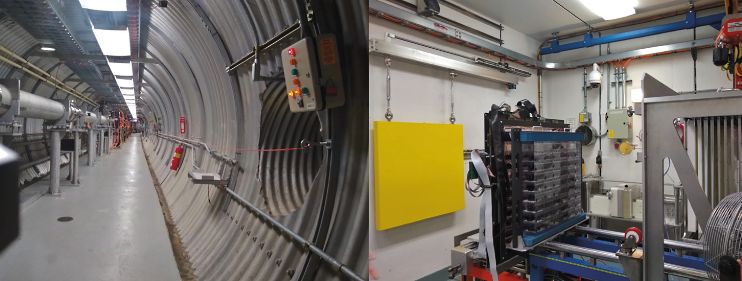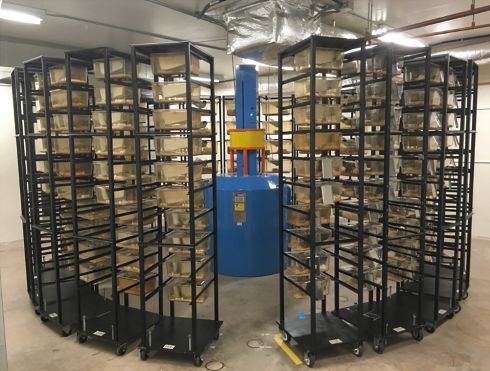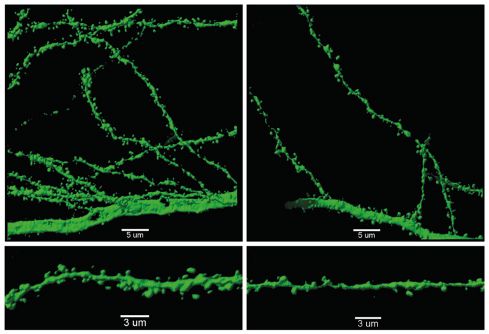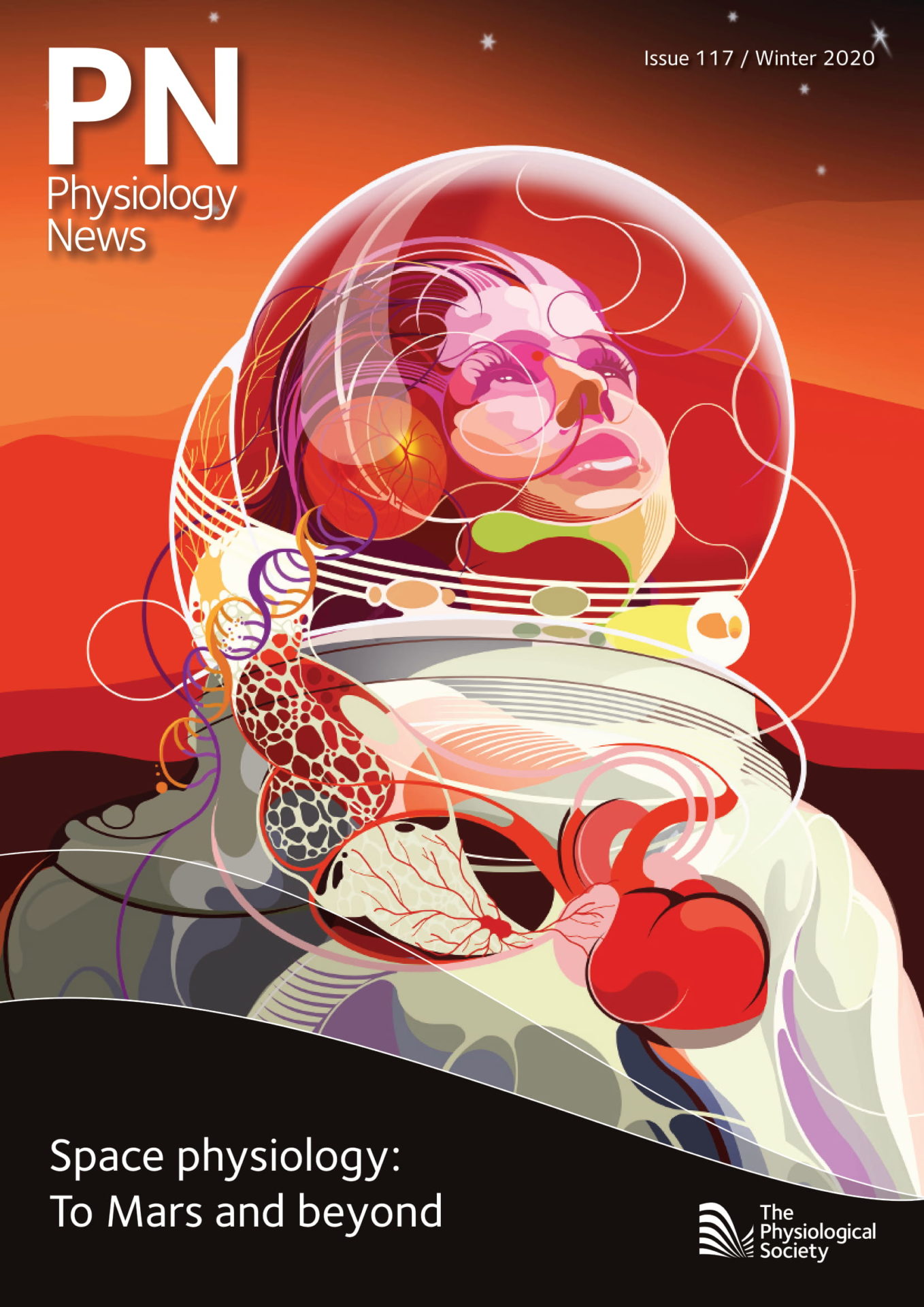
Physiology News Magazine
Space brain
The adverse impact of deep space radiation exposure on the brain
Features
Space brain
The adverse impact of deep space radiation exposure on the brain
Features
Charles Limoli
University of California, USA
https://doi.org/10.36866/pn.117.26
Until recently, the effects on the brain of solar and galactic cosmic rays (GCR) at total doses (≤50 cGy) and dose rates (~1 mGy/day) that define the space radiation environment were unknown. Of the wide range of physiological stressors that astronauts would be exposed to during a deep space mission, this is perhaps the most concerning, as these radiation fields possess energies sufficient to penetrate the hull of the spacecraft and tissues of the body, leaving a wake of subcellular damage along the particle trajectories that can compromise the functionality of cells, tissues and organs. Space- relevant radiation exposure to the brain elicits a wide range of behavioral decrements in rodents, and has been shown to occur following a variety of exposure paradigms (radiation types, doses, dose rates) which poses certain concerns to NASA since with our current technology, there is no way to completely protect or shield astronauts from space radiation.

To begin with, significant effort has been devoted to simulating space radiation on Earth, which as one might imagine is not a trivial undertaking. Most of our current knowledge about the biological effects of space radiation exposure have come from studies conducted at the NASA Space Radiation Laboratory (NSRL). The NSRL uses beams of heavy ions extracted from the booster accelerator at Brookhaven National Laboratory (BNL) to simulate exposures to various combinations of cosmic rays (see Whittaker p.36). It is interesting to note how this state-of-the-art facility has evolved over the last 20 years during which time NASA has funded researchers to unravel the various biological consequences of exposure to space radiation. NASA opening the NSRL (circa 2003) that featured a dedicated beam line for radiobiological studies represented a massive step forward for research. At that time, technical capabilities provided for exposures to single ion types at various doses, but capabilities have advanced to allow delivery of combinations of different ions on the same or different days. Another important advancement was the development of a larger, uniform field size that allowed investigators to irradiate greater numbers of experimental models (e.g. cells, tissues, animals) at the same time. Moreover, an enhanced capability to “switch” beam types and energies to provide more realistic simulations of the space radiation environment was also developed. More recently, physicists at BNL have made the necessary advancements to provide a remarkably complex and realistic simulation of GCR; namely, sequential exposure of multiple samples to a complex mixture of 33 beams comprised of multiple ion types and energies. The capability to deliver this complex radiation field in a single day or even over weeks provides investigators with an unprecedented tool to determine the effects of the most realistic terrestrial-based GCR simulation available on physiology. Some examples of the NSRL facility and a typical experimental set-up are shown in Fig. 1.

As with most experimental set-ups involving accelerator-based research, operational logistics pose practical limitations that preclude operation of the NSRL around the clock. This necessitated a slightly different approach to more accurately simulate the constant low dose rate environment of space. To this end, a neutron irradiation facility at Colorado State University (CSU) has been built that implements the radioactive isotope 252Californium (252Cf) to allow long-term, chronic exposures at realistic dose rates. In this instance, the experimental setup is rather distinct from that at the NSRL, where the radioactive 252Cf source is raised and lowered within a lead-shielded compartment to bathe a room with neutron and photon irradiation. Experimental models can be arranged in an annulus around the source at a defined distance that prescribes the desired dose rate. The source is raised while the samples accumulate the desired dose but can be lowered for animal husbandry purposes. With this system, researchers now have
at their disposal a new-found capability to expose specimens over the course of several months to low radiation dose rates that simulate many of the dosimetric qualities of the space radiation environment. An example of the neutron irradiation facility at CSU and typical cage arrangement surrounding the 252Cf source is shown in Fig. 2.

Behavioural and neurocognitive changes triggered by cosmic radiation
As the use of these highly sophisticated radiation facilities continues, what have scientists learned regarding the consequences of space radiation exposure to the brain? The answer is not good, at least for behavioral performance. Several studies conducted using rodent models over the last decade at BNL and more recently at the CSU neutron facility – implementing single ion, combined ions, or various versions of the most current GCR simulation – uncovered significant radiation-induced deficits in learning, memory and distress behaviors (Parihar et al., 2015, 2016). If the results hold true for humans, which neurocognitive data from the NASA Twins Study indeed suggest may be the case (Garrett-Bakelman et al., 2019; see p. 16), it may influence an astronaut’s ability to adapt and respond to unexpected or stressful situations during the near complete autonomy of deep space travel. Clearly, this is an undesired outcome and could jeopardise astronaut safety and mission success.
Radiation-induced cognitive dysfunction has been a bane for clinicians engaged in the radiotherapeutic management of CNS malignancies for decades. While cranial radiotherapy has proven useful for forestalling brain tumor growth, the progressive and debilitating cognitive deficits resulting from such brain tumor treatments have remained an unmet medical need for decades. This reality has foreshadowed many of the findings uncovered by NASA investigators despite much lower total radiation doses and much different radiation types used than that commonplace in clinical practice. Findings from multiple research labs documenting widespread neurocognitive deficits spanning multiple regions of the brain (e.g. hippocampal, medial prefrontal cortex, perirhinal cortex, among others) suggest that whole-body exposures will elicit widespread, network-level disruptions in neurotransmission.
Implementation of a variety of behavioral tasks designed over the years to interrogate the functionality of specific regions of the rodent brain have routinely uncovered cosmic- radiation-induced deficits when compared to similarly treated, yet unexposed, cohorts. As cognitive data sets have accumulated, some surprises have emerged. For one, neurocognitive outcomes measured after a variety of exposure paradigms do not show a strong dependence upon radiation quality, a term that reflects the energy deposition and ionisation pattern that a given type of radiation causes within a cell. Moreover, there are ill-defined dose-responses in the low dose range (≤50 cGy) that would be representative of the accumulated absorbed dose on a mission, for instance, to Mars. Given these low doses, most of the CNS effects are unlikely to result from overt cell death. Cosmic-radiation-induced cognitive dysfunction is also persistent, and shows little signs of improvement, at least over the timeframe of most published studies (3 to 12 months). The lack of dependence on radiation quality and total radiation dose, as well as the persistence of such cognitive deficits found in rodent studies, have brought to question precisely what the critical radiation-sensitive target in the brain is.
Cosmic radiation-induced structural alterations in the brain
While the foregoing highlights some of the complexities and paradoxes surrounding the functional responses of the space-irradiated brain, or “Space Brain”, some hints at the underlying mechanisms have been uncovered. Past work from us and others has found that mature neuronal populations in the brain are subject to radiation-induced structural alterations. Dendrites of many different subclasses of neurons are thin projections that interconnect to other neurons and mediate neurotransmission. Cosmic radiation exposure has been shown to compromise the integrity of these structures leading to marked and persistent reductions in the length, branching and overall complexity of the dendritic tree (Parihar et al., 2015, 2016). Dendritic spines that decorate the length of dendrites represent the structural correlates of learning and memory and contain the synaptic machinery that mediates neurotransmission. Cosmic radiation exposure causes dramatic reductions in dendritic spine density, along with drops in synapse density and axonal myelination – all factors that can compromise neurotransmission and cognition (Parihar et al., 2015, 2016; Dickstein et al., 2018). Examples of some radiation-induced structural changes to neurons are shown in Fig. 3.

Coincident with the structural alterations are increases in neuroinflammation, where cosmic-radiation-induced elevations in microglia serve to perpetuate the footprint of radiation injury in the CNS (Parihar et al., 2016). Activated microglia can actively re-shape and prune the dendritic landscape and trigger inflammatory cascades that disrupt the delicate balance between excitatory and inhibitory signaling in the irradiated brain. The fact that inflammation remains elevated over extended post-irradiation times (≤12 months) suggest this to be contributory if not causal to many of the cognitive decrements observed in rodents exposed to cosmic radiation.
At the electrophysiological level, circuits connecting the neurons into networks have been found to operate less efficiently. Intrinsic cell properties were altered, communication between individual cells was disrupted and memory facilitation along defined networks was impaired, with a collective and adverse impact on neurotransmission at multiple levels (Parihar et al., 2018). Resultant perturbations to oscillatory circuits, broken connections in combination with altered neurotransmitter availability, radiation-induced oxidative stress and changes in lipid oxidation are all additional factors identified by various investigators that could conceivably play significant roles in disrupting electrical communication within the irradiated brain and promoting the onset of cognitive dysfunction.
Neuroprotection in space?
What recourse does NASA and humanity have in protecting the brain and overall health of astronauts exposed to space radiation? At present, two approaches are the most promising for limiting the adverse health effects of cosmic radiation exposure. The first and perhaps most obvious involves improvements in radiation shielding. While cost and technology limit the payloads we can launch into space, a problem that may in part be resolved by manufacturing and assembling shielding materials in space at orbiting gateways, the fundamental problem remains, namely increasing the number of nuclei in between the cosmos and the body of an astronaut. In the end, this equates to increasing hull thickness and/or redistributing the payload cargo (e.g. instrumentation, food and water) within the ship to provide more optimised regions of minimal radiation exposure. More advanced engineering options are certainly under development of which specialised space helmets may be particularly important for neuroprotection.
The second approach involves identifying pharmacologic/dietary countermeasures for protecting the brain and the rest of the body against radiation-induced normal tissue toxicities. This is a multifaceted approach that is limited in part, as with other aspects of the space program, by practicality and resources. At this juncture, NASA is not in the business of drug development and is better suited to an approach aimed at identifying and/or repurposing an agent already known to be safe and efficacious for an alternative indication. Current research is actively exploring compounds possessing antioxidant, anti-inflammatory and metabolic enhancement properties that have shown some promise in rodent models at reducing radiation-induced complications in the brain and peripheral tissues. Adjusting diets to include foods containing many of the aforementioned properties represents a complementary approach. While further studies are clearly needed, a combination of pharmacologic and/or dietary countermeasures along with enhanced shielding should provide some meaningful mitigation to the radiation problems inherent to deep space travel.
While the work from our laboratory and that of our colleagues implicate GCR exposure to be a significant obstacle to deep space travel, it should not be viewed as a deal breaker for the long-term presence of humans in space (Limoli, 2017). Research identifies risks and uncertainties and provides for contingencies, thereby minimising the adverse impact of unexpected events. While the potential for deep space radiation exposure to compromise neurocognitive functionality presents a concern it also represents a challenge that can be overcome. With proper knowledge, motivation and resource allocation, deep space exploration can be undertaken with acceptable risk. Despite the known and the unknown risks of “Space Brain”, humankind will persevere and continue the exploration of the cosmos.
References
Dickstein DL et al. (2018). Alterations in synaptic plasticity and myelination in response to exposure to high-energy charged particles. The Journal of Comparative Neurology 526(17), 2845 – 2855. DOI: 10.1002/cne.24530
Garrett-Bakelman FE et al. (2019). The NASA Twins Study: A multidimensional analysis of a year-long human spaceflight. Science 364(6436), eaau8650. DOI: 10.1126/science.aau8650
Limoli CL (2017). Deep-space deal breaker. Scientific American 316(2), 54 – 59. DOI: 10.1038/scientificamerican0217-54
Parihar VK et al. (2015). What happens to your brain on the way to Mars. Science Advances 1(4), e1400256. DOI: 10.1126/sciadv.1400256
Parihar VK et al. (2016). Cosmic radiation exposure and persistent cognitive dysfunction. Scientific Reports 6, 34774. DOI: 10.1038/srep34774
Parihar VK et al. (2018). Persistent nature of alterations in cognition and neuronal circuit excitability after exposure to simulated cosmic radiation in mice. Experimental Neurology 305, 44 – 55. DOI: 10.1016/j.expneurol.2018.03.009
